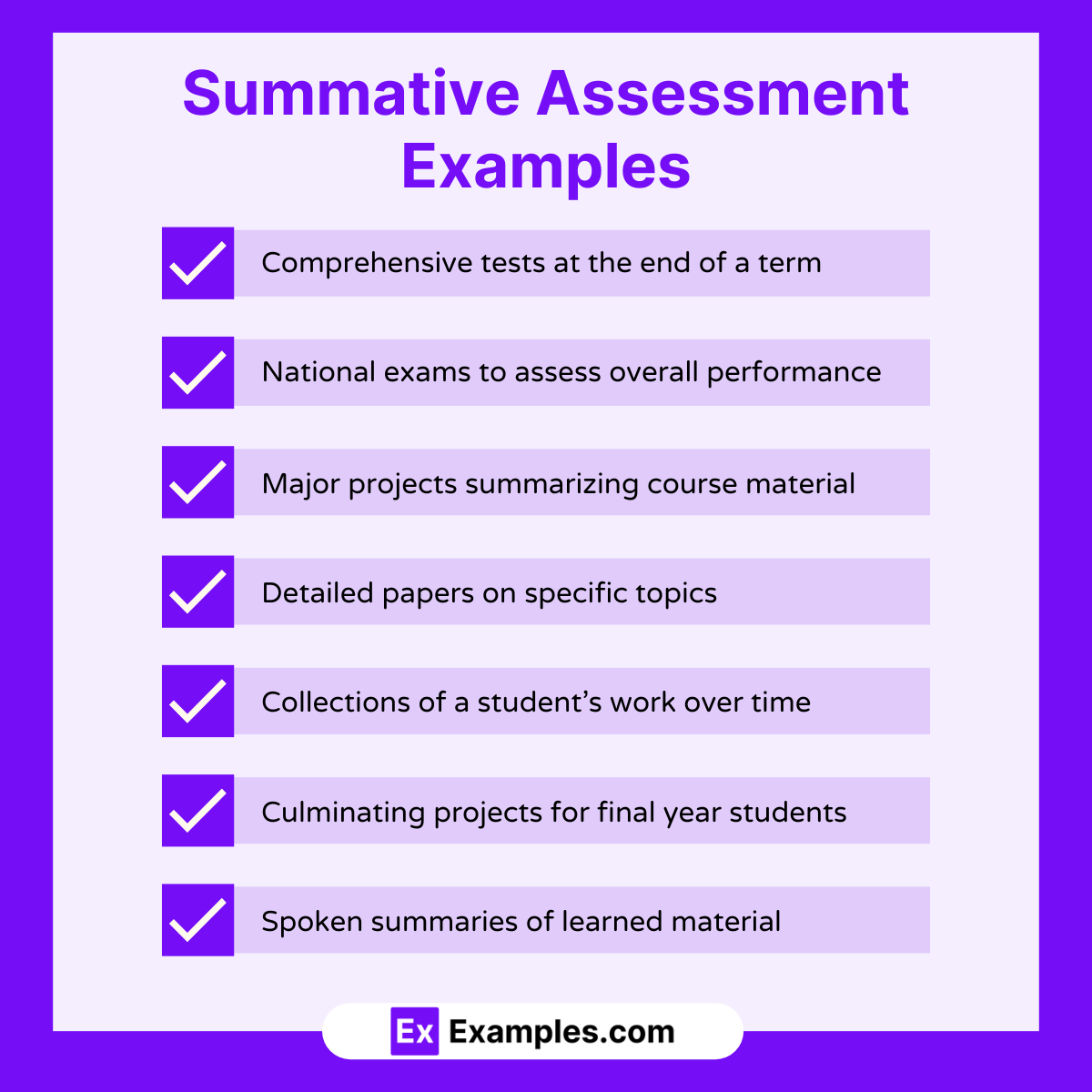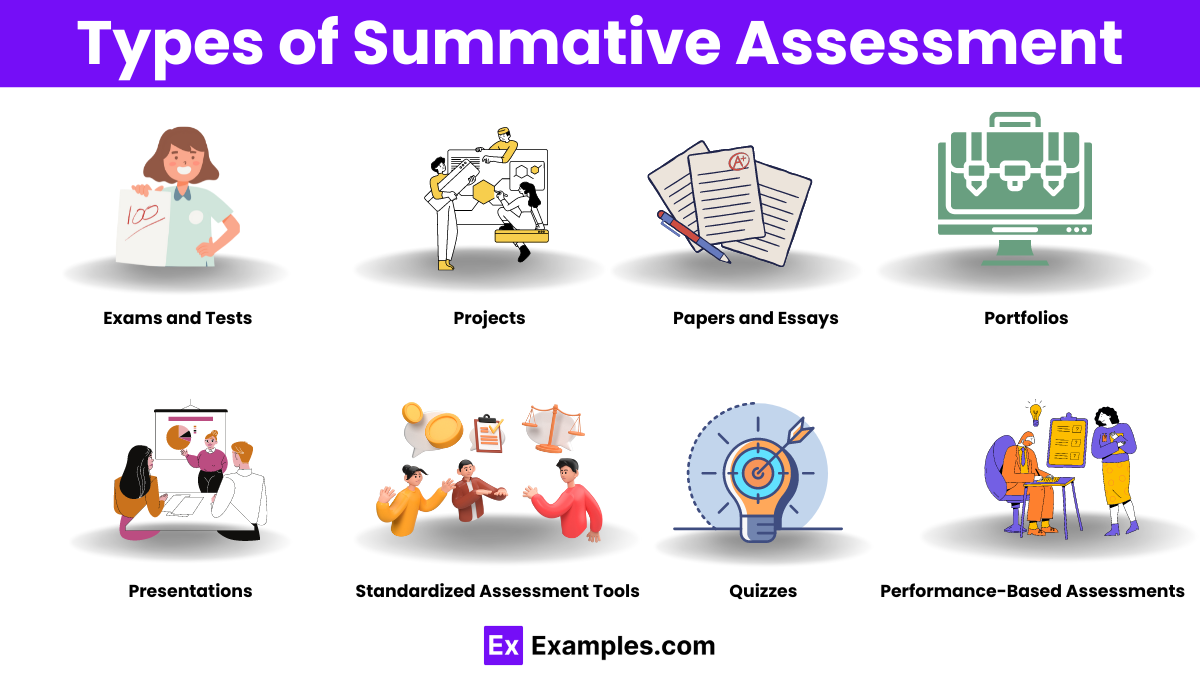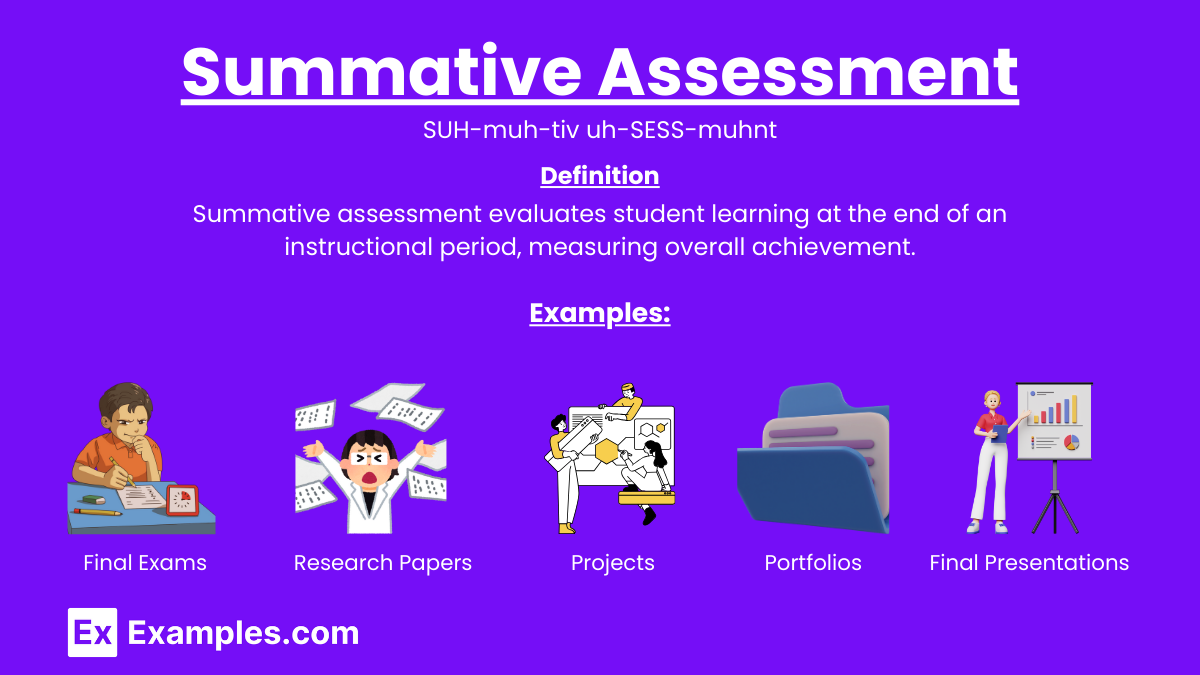10+ Summative Assessment Examples to Download
Summative assessment evaluates student learning at the end of an instructional unit by comparing it against a standard or benchmark. Teachers use it to measure students’ understanding and mastery of the material. Summative assessments, such as final exams, end-of-term projects, and standardized tests, provide a snapshot of students’ academic performance. These assessments play a crucial role in determining grades, informing instruction, and guiding future educational decisions. They help educators identify areas where students excel and where they need improvement, ensuring that educational goals are met.
What is Summative Assessment?
Summative assessments are essential for assessing learning objectives. Learning outcomes describe what students should learn and be able to do after taking a course or program. The summative assessment determines a course’s final grade. Summative assessment helps instructors determine whether students have learned enough to pass a course or program. statistics reports like this are essential for determining effective classroom management plan success and planning.
Summative Assessment Examples

- Final Exams: Comprehensive tests at the end of a course covering all material taught.
- Standardized Tests: Assessments like SAT, ACT, or state exams that measure student performance against a standard.
- End-of-Term Projects: Large projects completed at the end of a term, such as research papers or science fair projects.
- Capstone Projects: Multi-semester projects in higher education that demonstrate a student’s learning and skills.
- Portfolios: Collections of student work over time, demonstrating progress and mastery of subject matter.
- Performance Tasks: Assessments where students demonstrate their knowledge and skills through a practical task, such as a lab experiment or a history presentation.
- Final Presentations: Oral presentations summarizing the key learnings and findings from a course or project.
- Cumulative Quizzes: Quizzes that cover all the material learned over a certain period.
- Written Essays: In-depth essays written at the end of a course to assess understanding and analysis of the material.
- Oral Exams: Verbal examinations where students answer questions or explain concepts to demonstrate their knowledge.
- Art Exhibitions: For art courses, a display of students’ artworks created during the term.
- Practical Exams: Hands-on tests in subjects like nursing, engineering, or culinary arts to assess practical skills.
- Final Reports: Detailed reports in subjects like business, science, or social studies summarizing research and findings.
- Certification Exams: Professional certification tests that students must pass to demonstrate their competence in a specific field.
- Comprehensive Skill Assessments: Evaluations of skills in areas like music, dance, or sports through performance and technique demonstration.
Summative Assessment Examples for Kindergarten
- Portfolios:
- Collecting a range of students’ work over time, such as drawings, writing samples, and projects.
- Teachers can assess growth in various skills, including fine motor skills, literacy, and numeracy.
- Performance Tasks:
- Story Retelling: Have students listen to a story and then retell it in their own words, assessing comprehension and narrative skills.
- Show and Tell: Students bring an item from home and explain it to the class, evaluating speaking and presentation skills.
- Checklists and Rubrics:
- Teachers can use checklists to record students’ mastery of specific skills, such as recognizing letters, counting objects, or following instructions.
- Rubrics provide clear criteria for evaluating the quality of students’ work, such as artwork or writing.
- Projects:
- Class Book: Create a class book where each student contributes a page, showing their understanding of a theme, like “All About Me” or “Animals”.
- Thematic Displays: Students create displays or posters on topics they’ve learned about, such as seasons, community helpers, or plants.
- Observations:
- Structured observations during play or specific activities can provide insights into social skills, problem-solving abilities, and other developmental milestones.
- Written Assessments:
- Worksheets: Simple worksheets can be used to assess skills like letter recognition, counting, matching, and basic writing.
- Drawing and Labeling: Students draw pictures and label parts, such as drawing a family and labeling members, assessing both artistic expression and literacy.
- Oral Assessments:
- Interviews: One-on-one interviews where teachers ask questions related to a topic, assessing verbal communication and understanding.
- Group Discussions: Facilitated discussions where students share what they’ve learned about a topic, assessing their ability to recall and articulate information.
- Interactive Assessments:
- Games: Educational games that reinforce learning objectives, such as matching games for letter sounds or number recognition.
- Technology-Based Assessments: Interactive activities on tablets or computers that evaluate skills through engaging tasks.
- Performance Assessments:
- Role-Playing: Students act out scenarios related to what they have learned, such as being a doctor, a shopkeeper, or a weather reporter.
- Songs and Rhymes: Singing songs or reciting rhymes learned during the unit, assessing memory and rhythmic skills.
- Parent Involvement:
- Home Projects: Assigning simple projects that students complete with their parents, such as creating a family tree or a “Me Box” with items that represent the child.
Summative Assessment Examples for Early Childhood
- Portfolios:
- Collection of a child’s work over time, such as drawings, writing samples, and project work.
- Includes teacher observations and notes on the child’s progress.
- Standardized Tests:
- Age-appropriate standardized tests to assess basic skills in areas like literacy and numeracy.
- Examples include the Woodcock-Johnson Tests of Achievement or the Peabody Picture Vocabulary Test.
- End-of-Year Reports:
- Comprehensive reports that summarize a child’s development and learning across various domains.
- Include teacher comments, checklists, and ratings on skills and behaviors.
- Performance-Based Assessments:
- Activities where children demonstrate their knowledge and skills through hands-on tasks.
- Examples include storytelling, solving puzzles, or participating in group projects.
- Checklists and Rating Scales:
- Tools used by teachers to rate a child’s performance against specific criteria.
- Include developmental milestones and learning standards.
- Observational Assessments:
- Structured observations of children during different activities and routines.
- Focus on specific skills such as social interaction, problem-solving, and physical coordination.
- Parent-Teacher Conferences:
- Meetings between parents and teachers to discuss the child’s progress and share assessment results.
- Provide a comprehensive view of the child’s development from both school and home perspectives.
- Learning Stories:
- Narrative assessments where teachers document and interpret significant moments of learning.
- Include photos, quotes from the child, and reflections on their development.
- Developmental Screenings:
- Tools used to identify children who may need further evaluation or support.
- Examples include the Ages and Stages Questionnaires (ASQ) and the Denver Developmental Screening Test.
High School Summative Assessment Examples
- Final Exams:
- Description: Comprehensive tests covering all material taught during the course.
- Purpose: To evaluate overall understanding and retention of course content.
- Standardized Tests:
- Description: Tests like SATs, ACTs, or state-specific exams.
- Purpose: To assess student readiness for college and adherence to state standards.
- Research Papers:
- Description: In-depth essays requiring research, analysis, and synthesis of information on a given topic.
- Purpose: To evaluate critical thinking, writing skills, and subject mastery.
- Project-Based Assessments:
- Description: Long-term projects such as science fair projects, history day presentations, or engineering designs.
- Purpose: To assess practical application of knowledge, creativity, and problem-solving skills.
- Oral Presentations:
- Description: Presentations on topics studied in class, often accompanied by visual aids or multimedia.
- Purpose: To evaluate public speaking skills, comprehension, and the ability to convey information clearly.
- Portfolios:
- Description: Collection of a student’s best work over the course of a semester or year.
- Purpose: To demonstrate growth, learning progress, and skill development in various subjects.
- Capstone Projects:
- Description: Comprehensive projects completed in the final year of high school, often interdisciplinary.
- Purpose: To synthesize learning from multiple areas and prepare for post-secondary education or careers.
Types of Summative Assessment

- Exams and Tests:
- Standardized Tests: National or state exams designed to measure students against a common standard.
- Final Exams: Comprehensive tests given at the end of a course covering all material taught.
- Midterm Exams: Exams given halfway through a course to assess knowledge up to that point.
- Projects:
- Research Projects: In-depth studies on a particular topic requiring investigation, analysis, and presentation.
- Capstone Projects: Cumulative projects typically completed at the end of a program, integrating knowledge from various courses.
- Papers and Essays:
- Research Papers: Detailed written reports on a specific topic, involving critical analysis and synthesis of information.
- Essays: Written responses to prompts that assess students’ ability to articulate and defend a position or analyze a concept.
- Portfolios:
- Academic Portfolios: Collections of student work that demonstrate learning and progress over time.
- Art Portfolios: Compilations of artistic works showcasing skills and creativity.
- Presentations:
- Oral Presentations: Students present their knowledge or research findings verbally, often with visual aids.
- Poster Presentations: Visual displays summarizing research or projects, typically presented at academic fairs or conferences.
- Performance-Based Assessments:
- Performances: Students demonstrate their skills through performances, such as in music, drama, or dance.
- Practical Exams: Hands-on tests in fields like medicine or engineering, where students perform specific tasks or procedures.
- Quizzes:
- Though often formative, quizzes can also be summative if they contribute significantly to a final grade or evaluate cumulative knowledge.
- Standardized Assessment Tools:
- ACT/SAT: Standardized tests used for college admissions in the United States.
- GRE/GMAT: Exams used for admission to graduate programs.
- Cumulative Reviews:
- Comprehensive Reviews: Assessments that require students to review and synthesize information from an entire course or program.
Formative assessment
Formative assessment refers to a range of formal and informal evaluation procedures conducted by teachers during the learning process. These assessments help modify teaching and learning activities to improve student attainment. The primary goal of formative assessment is to monitor student learning to provide ongoing feedback that can be used by instructors to improve their teaching and by students to improve their learning.
Examples of Formative Assessment
- Quizzes and Polls: Short, ungraded quizzes or polls to gauge understanding of the material.
- Observations: Teachers observe students during class activities and discussions to assess their engagement and comprehension.
- Questioning: Asking open-ended questions during a lesson to check for understanding and stimulate critical thinking.
- Peer Assessment: Students assess each other’s work, providing feedback and learning from their peers.
- Self-Assessment: Students reflect on their own learning, identify areas for improvement, and set goals.
- Exit Tickets: Brief prompts or questions given at the end of a lesson to assess what students have learned and identify any remaining questions or concerns.
- Journals and Learning Logs: Students keep records of their learning experiences, progress, and reflections.
- Concept Maps: Students create visual representations of their understanding of a topic, helping teachers identify gaps in knowledge.
Formative vs Summative Assessment
| Aspect | Formative Assessment | Summative Assessment |
|---|---|---|
| Purpose | To monitor student learning and provide ongoing feedback | To evaluate student learning at the end of an instructional period |
| Timing | Conducted during the learning process | Conducted at the end of a unit, course, or term |
| Frequency | Frequent and ongoing | Typically occurs at the end of a term or unit |
| Focus | Identifying areas for improvement and guiding future learning | Measuring the extent of student learning against standards or benchmarks |
| Feedback | Detailed, specific, and constructive feedback | Summary feedback, often in the form of grades or scores |
| Examples | Quizzes, peer reviews, draft submissions, observations | Final exams, standardized tests, end-of-term projects |
| Student Involvement | High, students often self-assess and reflect | Lower, students mainly receive results |
| Impact on Grades | Low to moderate, primarily for guiding learning | High, usually a major component of final grades |
| Stakeholders | Teachers and students | Teachers, students, parents, administrators |
| Adaptability | Flexible, can be adapted based on immediate needs | Fixed, follows a predetermined schedule and structure |
What is the Primary Goal of Summative Assessment?
The primary goal of summative assessment is to evaluate student learning, skill acquisition, and academic achievement at the end of an instructional period, such as a unit, course, semester, or school year. It aims to determine the extent to which students have met the learning objectives, inform final grades, and provide data on the effectiveness of the curriculum and teaching methods. Summative assessments also serve as tools for accountability, ensuring that educational standards are met, and for credentialing, certifying that students have acquired the necessary competencies for progression or graduation. Examples include final exams, standardized tests, and end-of-term projects.
When to use Summative Assessment
- End of a Unit or Course: Summative assessments are typically administered at the end of a specific unit, course, semester, or academic year to determine whether students have mastered the material.
- Certification and Qualification: When a certification or qualification is required, summative assessments are used to certify that the student has the necessary knowledge and skills. Examples include final exams, standardized tests, and professional certification exams.
- Grading and Reporting: These assessments provide a way to assign grades or scores that can be used for report cards, transcripts, and other forms of academic record keeping.
- Curriculum Effectiveness: Summative assessments can help educators and administrators evaluate the effectiveness of the curriculum and make decisions about future instructional strategies and curriculum development.
- Accountability: Schools and educational programs often use summative assessments to demonstrate accountability to stakeholders such as parents, school boards, and government bodies. They show that students are meeting established learning standards and benchmarks.
- Program Evaluation: These assessments can be used to evaluate the effectiveness of educational programs and initiatives, guiding decisions about program continuation, modification, or discontinuation.
- Placement Decisions: Summative assessments can be used to make decisions about student placement in advanced courses, special programs, or remediation.
Characteristics of Summative Assessments
- Evaluative: They are used to measure the level of learning or achievement after instruction has been completed.
- Finality: These assessments are usually administered at the end of a learning period, unit, semester, or academic year.
- Comprehensive: They cover a broad range of material that was taught during the instructional period.
- High Stakes: The results of summative assessments often have significant consequences, such as determining final grades, advancement to the next grade level, or graduation.
- Standardized: Many summative assessments are standardized to ensure consistency and comparability across different student groups.
- Formal: These assessments are usually more formal and structured than formative assessments, often taking the form of tests, exams, or final projects.
- Performance-Based: They evaluate the overall performance and understanding of students on the subject matter.
- Feedback and Reporting: Summative assessments provide feedback that can be used to inform stakeholders, such as students, parents, teachers, and administrators, about the student’s academic progress.
- Benchmarking: They are used to benchmark student performance against standards or expectations, such as state or national standards.
- Criterion-Referenced: They often compare student performance against a predetermined standard or criteria rather than against other students’ performances.
Benefits for Students
- Measures Learning and Mastery:
- Summative assessments provide a clear measure of what students have learned and how well they have mastered the course material. This helps students understand their level of knowledge and skills in the subject.
- Feedback and Motivation:
- These assessments offer valuable feedback to students about their strengths and areas for improvement. Knowing their performance can motivate students to put in more effort and improve in areas where they are weak.
- Goal Setting and Accountability:
- Summative assessments encourage students to set learning goals and hold themselves accountable for meeting them. The need to perform well in these assessments can drive students to stay focused and disciplined throughout the course.
- Preparation for Future Assessments:
- Performing well in summative assessments can build students’ confidence and prepare them for future academic challenges, including higher education entrance exams and professional certification tests.
- Skill Development:
- These assessments often require students to demonstrate critical thinking, problem-solving, and effective communication skills. Preparing for and taking these exams can enhance these important skills.
Can summative assessments be used for grading purposes?
Yes, summative assessments often contribute to students’ final grades and academic transcripts.
How can educators ensure the validity and reliability of summative assessments?
By aligning assessments with learning objectives, using clear and fair evaluation criteria, and minimizing bias in scoring.
How do students prepare for summative assessments?
Students prepare by reviewing course materials, studying key concepts, practicing problem-solving skills, and seeking clarification on unclear topics.
Are summative assessments used in all educational levels?
Yes, summative assessments are used in K-12 education, higher education, and professional training programs.
Can summative assessments be used to assess skills other than academic knowledge?
Yes, they can assess skills such as critical thinking, problem-solving, communication, and creativity.
How do summative assessments contribute to educational accountability?
They provide data on student achievement, which is used to evaluate the effectiveness of educational programs and inform decision-making.
What is the role of feedback in summative assessments?
While summative assessments primarily focus on measuring outcomes, feedback can still be provided to help students understand their strengths and areas for improvement.
How can technology be integrated into summative assessments?
Technology can be used for online testing, digital portfolios, automated grading, and data analysis to enhance the efficiency and effectiveness of summative assessments.
Can summative assessments be customized for different student needs?
Yes, accommodations and modifications can be made to accommodate diverse learning styles, abilities, and special needs.
How do educators use summative assessment data to inform instruction?
Educators analyze assessment data to identify trends, strengths, weaknesses, and areas for instructional improvement in future courses.
What are some considerations for designing effective summative assessments?
Considerations include clear learning objectives, appropriate assessment methods, fair and reliable grading practices, and alignment with curriculum standards.


